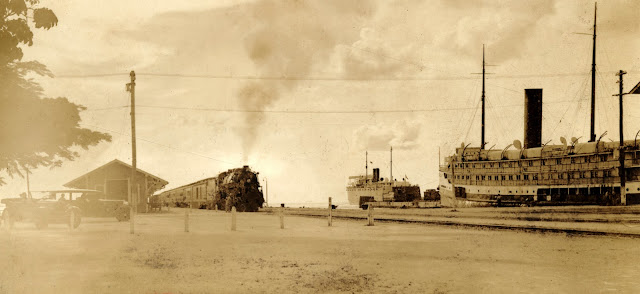This is a recent photo of the house we lived in for 6 years. It hasn't changed a bit on the outside.
The red arrow marks the house. There is a cafe marked up the street. David Wood and I would occasionally have beers there. It was less than a 5-minute walk from the house. The area in green was the Domaine de Cambron. The domaine is now known at the Pairi Daiza -- a wonderful zoo. Wish it had been there when we lived in the area. Check them out here: https://www.pairidaiza.eu/en.
Twelve monks from
Clairvaux arrived at Cambron on August 1, 1148. They were sent by
St. Bernard, abbot of Clairvaux, at the invitation of Anselm of Trazegnies, lord of Péronnes-lez-Binche and canon and treasurer of the Collegiate Chapter of
Soignies, who offered land on the banks of the
Dender for the foundation of an abbey. Living conditions were rudimentary. However, the Cistercian Order had already become prestigious. A Cistercian, the abbot of Tre Fontaine, had just been elected as
Pope Eugene III.
According to Émile Poumon, St. Bernard stayed in Hainaut in 1148, when the abbey was founded. St. Bernard visited Cambron in 1150, by which time the monks were facing significant difficulties. The endowment from Anselm of Trazegnies was contested by his brother Gilles of Silly. The abbey, however, managed to win the case. The first abbots were skilled administrators, as well as religious men, who brought together temporal competence and spiritual vigor. Fastré de Gaviamez, the second successor to St. Bernard, was an especially successful abbot.
By the end of the 14th century, there were more than 70 monks at Cambron pursuing the abbey's charitable mission. The monks increasingly recruited the aid of lay-brothers to tend the fields. The contribution of agricultural techniques to the local peasantry substantially improved both the status of the rural class and the local economy.
After facing difficulties in the 15th century, the abbey contributed greatly in the 16th century to the renaissance in the arts and in theology. The master of novices André Enobarb, a distinguished humanist who corresponded with
Erasmus, wrote a Latin tragedy about the miracles of Our Lady of Cambron. The abbot Robert d'Ostelart (d. 1613), supported the college in
Ath and provided scholarships for theology students at
Leuven. There were many other eminent monks at Cambron. Jean d'Assignies and Gregory de Lattefleur would both later become abbot of
Nizelles. Baudouin Moreau, author of a famous commentary on the
Rule of St. Benedict, became an emissary of the Cistercian Order in Rome. Jean Farinart, of Chièvres, who succeeded Robert d'Ostelart as abbot, was an excellent theologian and doctor of theology at
Douai. Antoine Le Waitte, author of a history of Cambron Abbey (1672), was the abbey's librarian and significantly expanded its collections.

By the 17th century, the abbey had become rich from years of gifts, legacies, and productive agriculture. The abbey enjoyed great renown, but strict adherence to monastic life had begun to loosen. The abbey's wealth attracted the envy of others. At the end of the 17th century, the wars of King Louis XIV devastated the province of Hainaut and set off the abbey's first period of decline.
At the beginning of the 18th century, a period of peace allowed for new prosperity, and a spate of construction and renovation. The majority of structures still visible at the site today date from this period. The entrance gate of the abbey was given a statuary niche that held an image of the Virgin Mary. The abbey's tower, built under the direction of the architect Jean-François Wincqz, was constructed in a pure
Neoclassical style. The carriage house, with five stalls and a dovecote in the center, is unique. The monumental staircase evokes the garden of a palace more than a monastery.
The abbey was still prosperous in 1782, at which time it had 58 monks. But in 1783, Holy Roman Emperor Joseph II, the so-called enlightened despot, classified Cambron Abbey as one of the useless monasteries and convents. It was therefore dissolved. The decision took effect in 1789. On May 27, 1789, the monks were expelled from the abbey and went into exile in the Netherlands.
The waning of Austrian power, hastened by the
Brabant Revolution, and the establishment of the short-lived
unified Belgian states, allowed the monks to return to the abbey for a time beginning in December 1789. Most of the buildings had already been looted. The subsequent French occupation would put an end to nine centuries of Cistercian life. Expelled by the
Revolutionary government, the monks left the abbey for good in 1797. The 44th and final abbot of Cambron, Florent Pépin, died in the Netherlands on November 16, 1795. The abbey's assets were sold and the buildings torn down by the succeeding owners.
It was later sold to the Counts of Val de Beaulieu, who built a large
château on the site and whose property it remained until 1993. It was then sold to the Domb family, who set up a zoo here, the present
Pairi Daiza.
In 1982 it was declared a protected area
Of the abbey buildings there still remain the tower of the abbey church of 1774, a monumental staircase of 1776, the entire medieval precinct wall and a 13th-century cellar that was formerly beneath the now-vanished lay brothers' quarters, measuring 12 metres by 18 metres with twelve pointed vaults, the main abbey gateway of 1722 and the former abbey farm with an 18th-century coach house. Remains of the former abbey church are kept in Attre Castle. In Bermeries near Bavay in France a grange of Cambron is still extant.

















